Was Brandon Wilson's Triton $25K Pre-Bubble Blast-Off GTO Approved?
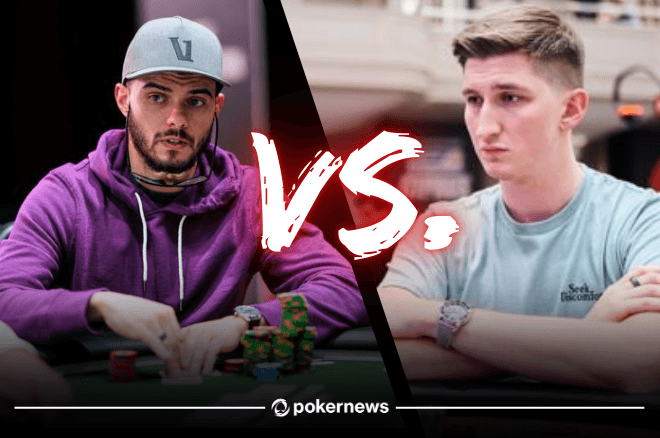
Brandon Wilson and Aliaksandr Shylko clashed in a hand of poker close to the bubble in this year’s Triton 8-handed 25k event.
Wilson put his tournament life on the line with a triple-barrel bluff, and Shylko sniffed it out. But was it GTO Wizard approved? Let’s find out:
Lay of the Land:
Field Size: 72/391 - Top 63 paid ($41,500 min-cash)
Blinds: 20k/40k/40k
Stack Sizes:
- Brandon Wilson UTG 870k
- Mikita Badziakouski +1 325k
- Nikita Kuznetsov 1.2m
- Patrik Antonius HJ 550k
- Kristen Foxen CO 1.4m
- Alex Kulev BTN 745k
- Aliaksandr Shylko SB 925k
- Fabian Bernhauser BB 325k
Preflop
Wilson opened two big blinds with A♠10♦ from under the gun (UTG), and Shylko flatted from the small blind (SB) with A♣Q♥. Both players played this street well, which you can see in the screenshots below.
ATo should always open from UTG, while AQo should be mixing roughly 50/50 call and all-in. Overall, Shylko needs to raise a very tight and snug range, due to high ICM pressure being close to the bubble. That’s why we see AQo being indifferent between all-in and call, although it would always go all-in if we hadn’t factored in ICM.
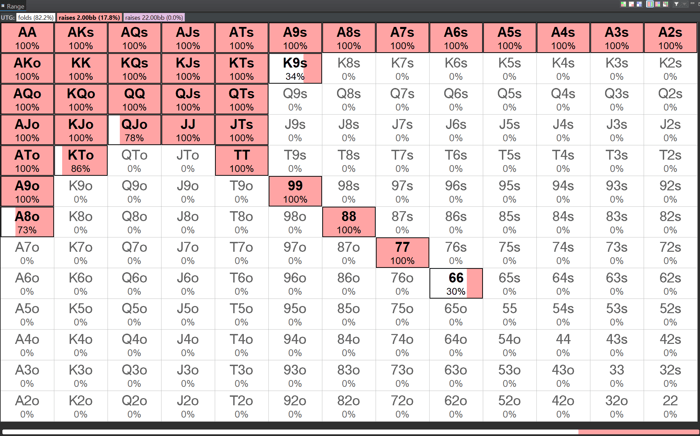
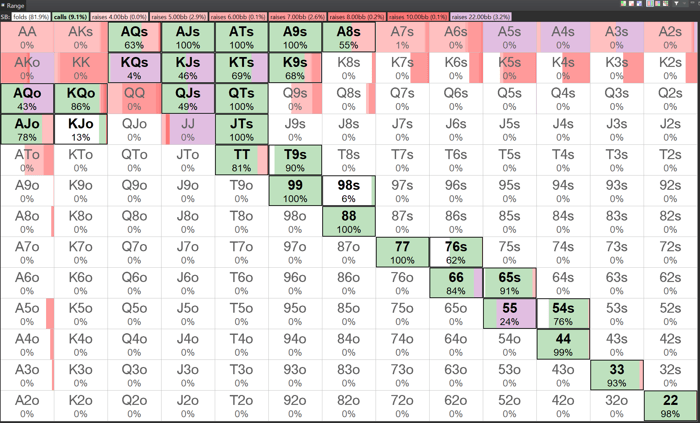
Flop
The flop came K♦8♦4♠, Wilson bet roughly 25% of the pot with his ace-high, and Shylko called with his better ace-high.
Wilson’s GTO Strategy
Wilson should bet 70% of the time on this board with most of his range for 25% pot, and always bet A♠10♦ specifically. Wilson's equity advantage on this favourable board is what allows him to bet so often. Pay attention to hands like AQs or 7x7x, which still prefer to check more often than bet, due to the fact that there is too little to gain by betting. Sevens and ace-queen suited are barely strong enough to bet for thin value.
Betting ATo as Wilson makes sense as a bluff, since Shylko needs to be folding some better hands, such as AJ, AQ, 33-22, at some frequency. Especially with a diamond, betting the flop is a good play, as the hand can barrel on many turns again due to blockers to flush draws that can call.
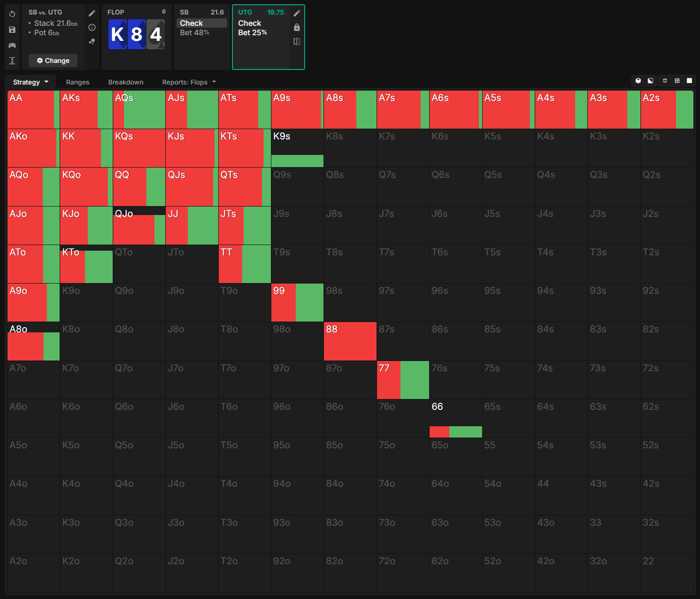
Shylko’s GTO Strategy
As can be seen in the screenshot below, Shylko’s hand is indifferent between calling and folding. He needs at least a diamond in hand for the backdoor flush draw to continue. If Shylko always folds AQo instead of mixing call and fold, Wilson should bluff more often on average to take advantage.

Turn
The turn brought the Q♣, giving Wilson a gutshot and improving Shylko’s to second pair (Board: K♦8♦4♠Q♣). Wilson fired again for a 40% pot bet, which Shylko hesitantly called.
Wilson’s GTO Strategy
According to the solver, this is a spot where the player in position (Wilson) needs to play a polarized strategy and bet two-thirds of the pot instead of 40%. If we compare EV, we will see that with a single bet size available, betting larger leads to a better expectation for Wilson.
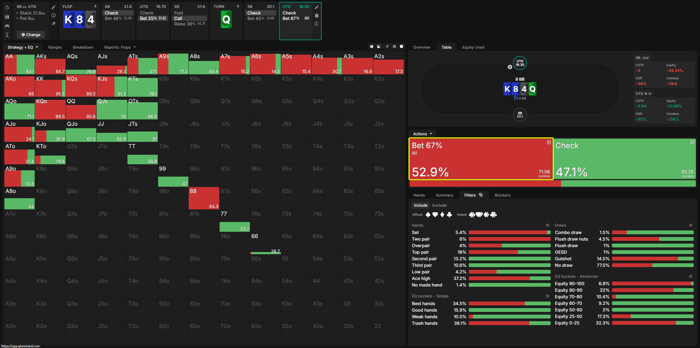
The reason is simple: the player who is in position gets to choose which of his hands are guaranteed to see a river, by checking them behind; something that’s not possible when out of position. Because of that, Wilson is incentivized to check back hands that don’t want to stack off when in position, and instead build his betting range around value hands that are willing to stack off. To maximize our EV with hands that want to stack off, we need to bet roughly 2/3 pot, which is the geometric bet size in this spot.
What even is a geometric bet size?
Betting the same size (as a percentage of the pot) on each street, such that chips are all-in on the river bet. This is the optimal bet size if one player is perfectly polarized relative to their opponent, as it generates the widest overall minimum defense frequency (MDF) that gets stacks in by the river.
So, was Wilson’s turn barrel a mistake?
All that being said, we can make a case here for Wilson potentially “splitting” his range into two bet sizes. He could be betting 40% with hands like second pair, and using the geometric 67% bet size for hands that are looking to stack off like AK, but it would make the strategy more complicated to execute without any EV gain in theory. For that reason, Wilson gets a pass here, and we will continue our analysis assuming he is splitting his range on the turn.
Let’s have a look what the GTO strategy for multiple sizes on the turn should look like:
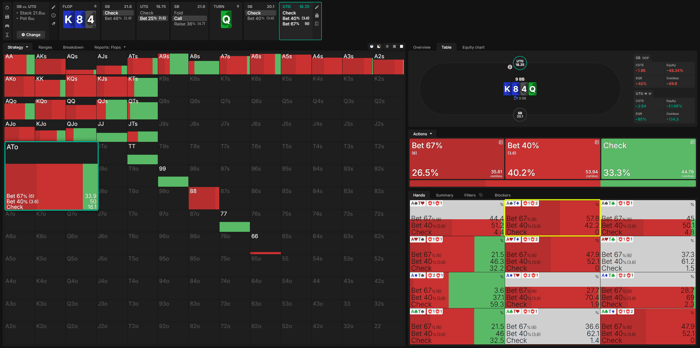
Here, we see that Wilson should always bet his gutshot because he can improve when called, but also gets better hands to fold, such as 99-22 and AJ. Something worth noting is that he can use either of the available sizes with his hand (40% or 67%). Solvers like putting their bluffs in all bet sizes that are used by value hands to balance their range with enough bluffs in all sizes, but also for board coverage.
It’s also worth noting that when the turn is a queen, a lot of Wilson’s air has now improved. This allows Wilson to bluff the turn at a high frequency in general.
What is Board Coverage in poker?
Board coverage in poker refers to a player's ability to make strong hands across a wide range of possible board textures.
Shylko’s GTO Strategy
As played, Shylko should always call his A♣Q♥ versus Wilson’s bet on the turn, as he is now not only beating all of Wilson’s bluffs, but also beats some value hands such as QJ. Anything worse than a queen becomes indifferent and should fold often to the turn bet, as you can see in the screenshot below:
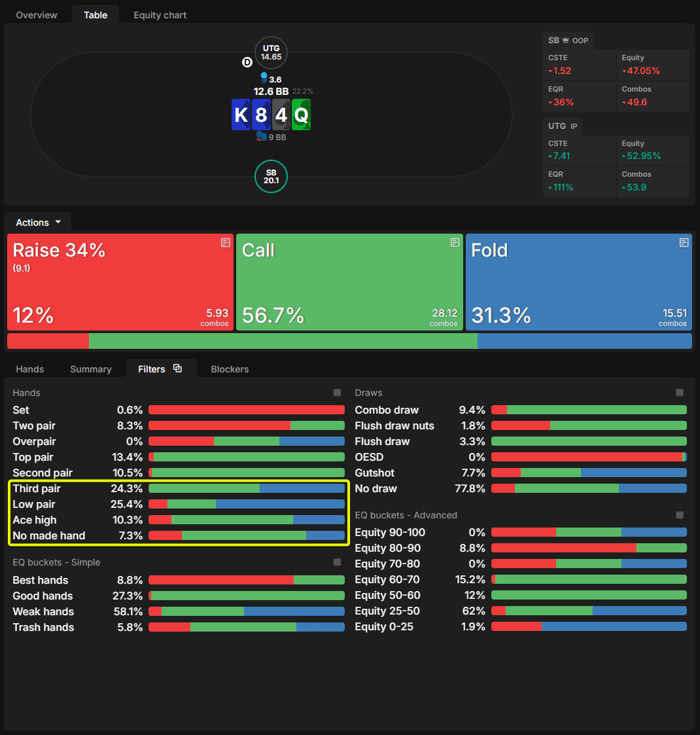
River
The river was the Q♦. Shylko checked a third time to his opponent, who decided to jam the river for all the remaining chips.
Shylko’s GTO Strategy
When the river completes flush draws or pairs the queen (or both as in this hand), Shylko can play a donk bet strategy due to an advantage in trips and/or flushes, to prevent losing value from top pair and some trips that Wilson should check back the river with. This advantage comes from the fact that a large part of Shylko’s continuing range from the turn is made of QxXx, KxXx and flush draws, while Wilson can bet the turn liberally, which dilutes his range with air.
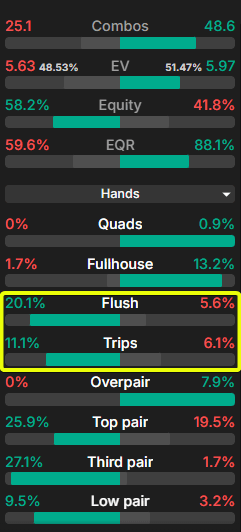
Because of that, Shylko should almost always donk bet the river for a small 25% pot size with his best trips and flushes as you can see below:
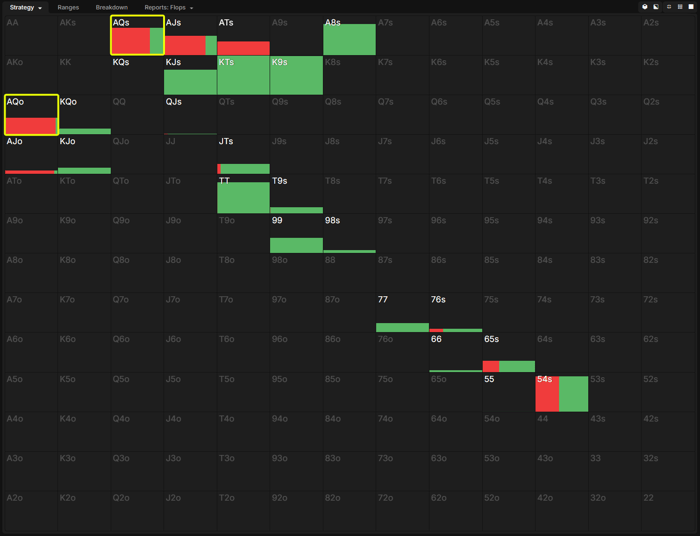
Since Shylko didn’t find the river donk bet, we will assume that he checks his whole range to Wilson and we will continue the analysis with that assumption.
As played, after checking and facing the all-in by Wilson, Shylko is now in a tough spot. His hand now beats bluffs, but is beaten by Wilson’s value hands. If Wilson does a great job of balancing his all-in with enough value and bluffs, most of Shylko’s AQ combos can’t be called profitably on the river.
Certain suits for AQ are slightly preferred over others, which sways some trips combos towards call and others towards fold. The A♣Q♥ specifically is always a call, because with the Q♥ not only does he beat bluffs, but also splits vs the AxQ♠ that should be the only trips combos in Wilson’s value jamming range (Qs blocks Shylko’s KQo full houses).

Wilson’s GTO Strategy
When Shylko decided to check again on the river, Wilson was faced with a big decision. To bluff and potentially risk busting before the bubble bursts, or not to bluff and accept defeat (but stay alive)?
Since the river is a bad card for Wilson, devaluing his top pairs that could stack off otherwise on other cards, he must be very careful and selective with bluffs.

Although it’s very tempting to bluff any diamond when diamonds get there on the river, Wilson must be very picky with bluffs when the river is one of the worst cards in the deck. For that reason, Wilson should only consider betting his best bluffs; in this case, the A♦10x (blocking Shylko’s likeliest flush).
On other diamond rivers that wouldn’t improve Shylko’s second pair to trips, Wilson’s “bluff allowance” would go up, and bluffing Ax10♦ would therefore be fine, as he would get called less often on average, making the river a safer card to bluff on.
Conclusion
To conclude, both played their hands fairly well, albeit slightly suboptimally. The flop was played strictly by the book by both. On the turn, Wilson abandoned the book and went for a smaller size than what is usual; not necessarily a mistake if he was splitting sizes, but still surprising to see, as splitting sizes in this spot is not common and could potentially be a leak after all. By the river, Shylko missed a donk bet with his trips, and Wilson went for a bluff that should’ve been a give-up.
Although both players deviated a little from GTO, the mistakes weren’t very far from optimal play in terms of EV. It's not 100% GTO Wizard approved, but nonetheless, well played!
Hand analysis provided by Sotirios "Sotos" Liakos in collaboration with GTO Wizard











